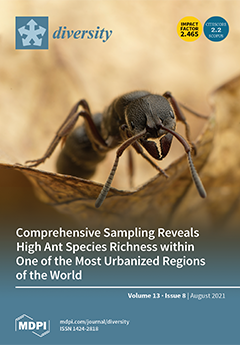Open AccessArticle
Bat Diversity in Cat Ba Biosphere Reserve, Northeastern Vietnam: A Review with New Records from Mangrove Ecosystem
by
Vu Dinh Thong, Annette Denzinger, Nguyen Van Sang, Nguyen Thi Thu Huyen, Hoang Trung Thanh, Dao Nhan Loi, Pham Van Nha, Nguyen Van Viet, Pham Duc Tien, Mao-Ning Tuanmu, Joe Chun-Chia Huang, Ladthavong Thongphachanh, Nguyen Thanh Luong and Hans-Ulrich Schnitzler
Cited by 7 | Viewed by 6312
Abstract
The Cat Ba Biosphere Reserve is internationally renowned for its spectacular karst landscape. It covers a large area with hundreds of limestone islands and various ecosystems including caves, tropical forests, and mangroves. However, previous surveys were only conducted in terrestrial ecosystems on Cat
[...] Read more.
The Cat Ba Biosphere Reserve is internationally renowned for its spectacular karst landscape. It covers a large area with hundreds of limestone islands and various ecosystems including caves, tropical forests, and mangroves. However, previous surveys were only conducted in terrestrial ecosystems on Cat Ba Island. Therefore, bats inhabiting mangroves and the remaining islands did not receive attention from scientists up to 2014. To initially fill in the gaps, we conducted ten bat surveys between 2015 and 2020 with an emphasis on mangroves and previously unsurveyed islands. Bats were captured using mist nets and harp traps. Twenty-three species belonging to 13 genera of six families were recorded during the surveys. Of these, four species (
Macroglossus minimus,
Myotis hasselti,
Phoniscus jagorii,
Tylonycteris fulvida) are new to the reserve. Remarkably, 15 species belonging to seven genera of five families were captured in mangrove, which is the highest species diversity for bats reported from any mangrove area in mainland Southeast Asia. Based on results from the surveys and literature review, we here provide the most updated bat diversity of the reserve with confirmed records of 32 bat species belonging to 16 genera of six families. Historical records of each species in the literature were reviewed. Two species,
Scotophilus heathi and
Scotophilus kuhlii, are unconfirmed because of unclear evidence in previous publications. Results of this study indicated that the mangrove ecosystem is important for bats but still poorly studied in Cat Ba Biosphere Reserve and Vietnam as a whole. In addition, morphological measurements, echolocation data, distributional records, and conservation status of each species are also given in this paper for potential research and conservation campaigns in the future.
Full article
►▼
Show Figures





